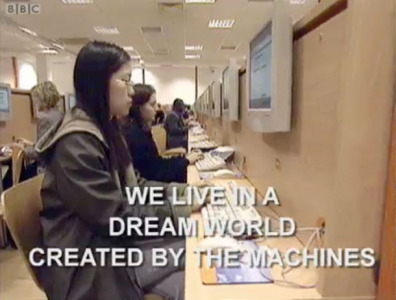Last week, we looked at the first part of Adam Curtis’ documentary All Watched Over by Machines of Loving Grace and the way in which the computer was granted omnipotence in the 1990s. In ‘Love and Power’, Curtis showed how Randian heroes from Silicon Valley promoted the idea that computers could stabilize societies through the economy. We all know that they were to be proved wrong.
Technology seems to trouble Curtis even further in the second episode of the series, ‘The Use and Abuse of Vegetational Concepts’. Don’t be put off by the wordy title; the episode is a little easier to understand than the first part of the documentary, largely centered around one technological theme. The episode begins with the dream of one man, a dream which would spark something entirely new in ecology and economics and once again, distort our concepts of the technology we surround ourselves with. Botanist Arthur Tansley had a dream in which he shot his wife and alarmed at the content, looked to Freud’s theory of the unconscious for answers. Soon, his reading led him to Freud’s writing on how the brain can be conceived of as an electrical machine, functioning and organizing information by passing signals from one area to another. The brain is a self-organizing organ in Freud’s theory, efficiently managing data. Tansley took this concept and believed that it could be applied to nature, too. He split nature into self-contained ecosystems, in which it was organised like a machine and, much like the brain, was self-organizing and self-correcting. Truthfully, it’s not hard to see why Tansley believed this; patterns in nature seem to be recurring and somehow self-fulfilling. When battered by natural disaster or environmental disaster, natural systems somehow always recover, growing back and continuing as before.
For a while, it seemed that other people agreed with Tansley’s beliefs and soon, figures in technology and ecology were starting to take an interest in his claims. Computer engineer Jay Forrester believed that brains, cities and societies could be compared as models of feedback networks, in which information was organised and fed back within the system. The three types of system could be controlled from the loops of feedback and self-regulated, essentially becoming self-sufficient. The concept of cybernetics was soon set up, promoting the same ideas, particularly focused towards humans. Cybernetics viewed humans not as fallible animals but rather, nodes in larger networks or machines. Humans functioned to make the whole work, a whole which was self-sufficient. Pretty soon, this belief was picked up by ecologists and transferred to the natural world. They believed that natural systems like the cybernetic system could stabilize the natural world and create incremental growth.
Ecologists soon began collecting data from natural ecological systems in order to build electronic systems which simulated how they worked. The hypothesis of the self-sufficient ecosystems became a certainty in the ecological world. However, the theory that the ecosystem was a self-balancing system had become hugely over simplified and was passed around as a distortion of the original idea. As a result, a number of small societies were set up, attempting to live according to the ecological oversimplification, assigning no individual as leader and instead assuming that the society would balance itself. The humans were merely cogs in the machine.
Unsurprisingly, these societies and theories soon began to break apart. In the 1970’s, a number of predator-prey studies were carried out which seemed to disprove the ecological theories. Studies of the relationship between wolves and elks in the wild showed huge variations over a number of centuries, suggesting that nature wasn’t as stable and self-sufficient as we originally thought. Nature wasn’t a stable mechanism and homeostasis was not possible. Similarly, computer models created in the same vein did not manage to stabilize proving that perhaps the self-sufficient systems of cybernetics were merely a thing of imagination.
Much like ‘Love and Power’, ‘The Use and Abuse of Vegetational Concepts’ shows a rift between how we conceive of computer systems and how they actually work. In both instances, authoritative figures massively oversimplified technology and assumed that it would sort itself out without the intervention of human minds. Whilst the concept of balanced societies is attractive, it is currently ineffective and impossible. The belief that things will retain momentum and growth without the inclusion of human manipulation or intervention is faulted at best.
Curtis shows similar theories in society. In the early 2000’s, waves of spontaneous revolutions across Asia and Europe seemed to disprove the earlier failure of cybernetics. Living in a post-revolutionary state, void of a recognizable leader, the social systems somehow managed to balance themselves and function effectively. However, after a few years things started to go downhill and, like earlier attempts, the experiments in social freedom ended prematurely due to power struggles amongst the participants. Self-organizing networks in any format – be it social, ecological or technological – can initiate and catalyse change but it is essentially unsustainable. Networks don’t have the capability to prolong the change that they create precisely because they are not free thinking. They are unable to predict how changes will occur over time or consider any future anomalies because they are not sentient. Change in ecology and technology, in this case, is random and potentially destructive. We cannot assign meaning to them as they function in a way entirely different from our own minds. Whilst computers are capable of working in a way similar to the brain, they are not brains. Of course, it’s not to say that things won’t change in the future but for the immediate present, at least, we are safe as free thinking machines.


